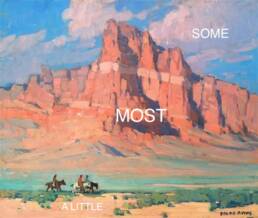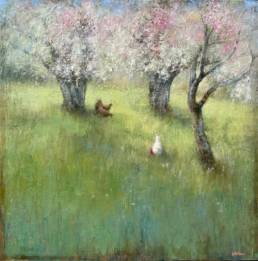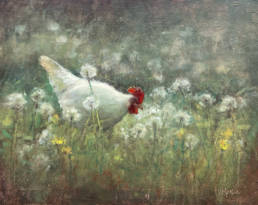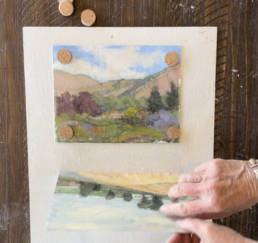Artists are self starters and so we need to stay motivated. There are many ways in which you can motivate yourself as a creative person. Here are 7 ways to get you inspired and motivated in the studio at the same time!
1. Organize your studio or working space
This is a “out with the old in with the new” type of philosophy. I do this about every 6 months or so. It’s extremely liberating to rid yourself of old stuff and stuff that just doesn’t serve you or your goals anymore. It’s also great to re-organize your current space.
There is always something to moving stuff around to. I know it’s a very Feng Shui thing but you do create new paths for energy to flow. I always feel fresh and newly inspired when a new “Spring” or “Fall” cleaning or new arrangement has occurred. I bet you will too.
Cleaning, re-arranging or organizing is a way to invite “instant motivation” to embark on a new series or just create space for something new to happen.
2. Interpret your work into another medium
It is so easy to create the same type of work time and time again, so this step is a big motivator for me. Why? because it’s easy. It’s what you know how to do. But perhaps try something different.
- Try, for example, to translate your work into another medium.
- If your a painter translate your recent work into a drawing or watercolor.
- If your a sculptor, translate your 3d work into a 2d one. You get the idea.
I love doing this for a number of reasons. One it allows you to almost instantly create more work. Second, it allows you to get lost in the physical process of creating the work. You don’t have to re-envision the whole composition.
No one does this better than painter Jasper Johns. Johns, who made the US flag quite famous continually “re-purposes” either parts or often times (in the case of the American Flag) the entire composition. See the many versions of Jasper Johns flags. You can easily do this as well.
3. Research and dig deeper into your craft
Recently, I did a tremendous amount of research into Van Gogh’s materials relating to a project I was working on. I called the Tate Gallery in London to speak with a conservation specialist, communicated with a number of other experts in museums through out the world to find out his exact materials, color palette, type of supports and painting techniques. It was immensely informing and enlightening at the same time. I felt like Sherlock Holmes trying to get to the bottom of some great mystery.
However, it really deepened my understanding of Van Gogh’s craft. His craft, of course, was an Alla Prima style of painting which encourages spontaneity sand is much much different, than say the process of Rembrandt who orchestrated translucent layers upon layers of oil paint.
So I encourage you to find out more about your materials or research famous art that particularly intrigues you. Find the best in your artistic niche and learn from them. Many of them have workshops and working seminars that can teach you more about your particular craft.
As your understanding increases your art will become all the more richer and deeper.
4. Visit Museums
Museum and shows are always inspiring and motivating. I was recently in NYC and went to see the show “Abstract Expressionist New York” at the Museum of Modern Art. It was a fabulous show. Nothing like seeing those amazing Rothkos, Pollocks, DeKoonings, Klines, etc. paintings up close and personal. You can really see (and feel) the commitment and conviction in these seminal works.
Of course, not everyone has availability to NYC or other metropolitan areas but there are always good, local museums in almost any part of the country. It’s really beneficial, I believe, to really slow down, get outside of yourself and immerse yourself in anothers work – whether or not it’s the same medium you work with. Just allow whatever inspiration is there to bubble up.
5. Take it up a notch!
What about creating something great. Not just “another” painting or sculpture or drawing. Ask yourself what qualities, themes, materials would I need to touch upon to create this. It’s really asking these big questions that will create great work.
Challenge yourself to aim high – up it a notch – to really raise the stakes in your work. Aim high. Once you begin operating from this new paradigm you’ll reach a new level of motivation.
6. Change your pace
This one is fun. Try to change the pace at which you create your artwork. If you tend to take a long time (say 3 weeks to create a painting) try to create one in a day. Or maybe a 10 paintings in 10 days.
On the opposite side, if you create your art quite quickly the try slowing down. Try to become more intricate in your process. See what it reveals.
7. Sell some artwork!
Nothing more motivating than selling some of your artwork. It’s immediately gratifying and motivational that other people find value in your artistic expression.
How? List a few pieces on Ebay, enter some local shows, add some Paypal buttons to your website, try newsletter art marketing, contact friends who might be interested and join social media sites.
There are tons of things you can do to sell more of your work. Just realize it doesn’t happen automatically. YOU initiate the conversations that result in sales. Once you see that $500 (or whatever) in your PayPal account or an email inquiry to purchase one of your works you will be motivated beyond belief to create more and more work to sell.
*****
Doug Farrick is an artist and entrepreneur. He has started and sold a number of online businesses. His latest venture is the Art Marketing Association, which will launch in early 2011. Doug recently, just wrote, shot, produced and edited his first DVD called, “An Introductory Guide to: Oil Painting Tools and Supplies”
Thanks for a great list of motivating ideas for us all! I look forward to trying some of these out next time I need a little motivational boost. Also, I am looking forward to being a part of the newly formed Art Marketing Association! ~Lori
PS. How do YOU stay motivated? Please share your tip in the comments. We all learn a lot from your great suggestions and feedback!
*****
You might like to read:
5 Common Traits of Successful Artists
Finding Your Own Artistic Voice
A Unique Approach Using Color Harmony to Improve Paintings
Use the Hidden Meaning of Color to Improve Paintings
The Importance of Being an Artist in Today’s Modern World
How to Bring out the Mona Lisa in Your Own Artwork
Learn the Two Biggest Mistakes Artists Make with Social Media









I have been feeling a little demotivated for last few days……And reading this article is such an inspiration in itself! I think the Universe is always conspiring to put me in the path of right articles at right time!
Well, what I would do in general to get out of a funk is to read! Read books and articles on art history mainly! Just to read about the great ones always make me want to do better!
Also, I visit museums and galleries, if the sense of lethargy refuses to leave me…. That is always an eye opener! When you see your contemporaries are working their butts off, you don’t want to sit on the couch and complain……! Hey, I think this might turn out to be a topic on my modest blog too:)
Oh Ishita, comments like yours are the reasons why I love to blog and keep at it! I am so happy this article helped you right when you needed it most.
We all have those ‘down’ moments…being a creative person is a lot of work and sometimes it is difficult to stay motivated when we are so busy or preoccupied with life.
I would love to see what you write about…
Here’s to a creative week-
Lori 🙂
Lori,
this is very helpful, again a great post. When we have those moments that nothing seems to happen, we should definitely take action. One of the things I do to get motivated is get started and use this technique: too many options make me wander around. So if I limit myself (time frame, topic, motif, medium, choice of colors etc.) I get more done and I am more creative.
Picasso once said: “If you have five elements available use only four. If you have four elements use three”.
I just wrote something about this: if you limit yourself, you’ll be more creative (http://www.flavordesigns.com/2011/01/be-more-creative/).
I found your suggestions very helpful and again I’ve learned one or two things 🙂
Franziska San Pedro
@FlavorDesigns
Always wonderful advice and help. Thanks.
Thank you for letting me know, Nadine. I always appreciate the feedback.
Lori 🙂
This was so very helpful, especially #1, #2 and #6. I’m stopping everything NOW to organize my working space. Thank you.
I totally agree with you Toni. When I am in a creative rut, a good ‘spring cleaning’ really helps me feel more motivated. I am happy you found some tips to help you!
Cheers-
Lori
Hi Lori ~ This is a great post!
Earlier this year I had to dis-assemble my studio. Just last night I worked on getting it put back together. I’m excited about having my space again!
I was previously painting large abstracts, and have sold a few. While I was in the studio transition, I began painting small 5×7 panels, and really do love them! We’re taking some of the framed panels to our space in Asheville this weekend, so I’m eager to see how they sell!
So glad I found your site!
Take good care ~
Jane
Hi Jane. Thanks for taking time to share your story with us here. I really appreciate it. Good luck in Asheville. I am glad you are creating and selling. Enjoy your new studio space and I hope to see you again.
Best-
Lori 🙂
Great article I think it is worthy of putting a print of it on the bulletin board in my studio!
Great Terri! I am glad this post helped you. Thanks for letting me know.
Lori 🙂
Excellent article! I’ll be passing it on!!!
You are very welcome, thanks for stopping by.
Lori